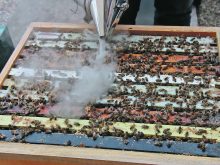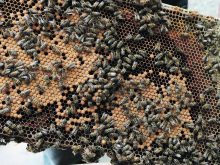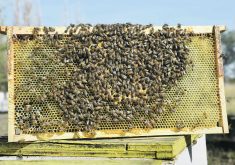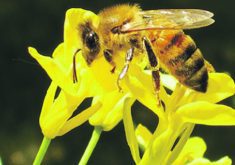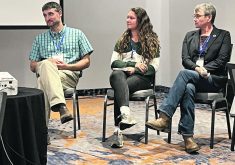The Western College of Veterinary Medicine hires veterinarian to serve as its first pollinator health research chair
From beef to bees, that’s the path Sarah Wood took to find her dream job as the first research chair in pollinator health at the Western College of Veterinary Medicine at the University of Saskatchewan.
“I’m here to stay… I have my dream job. I don’t need another job for the rest of my life,” she said.
Born in Yorkton, Sask., Wood spent her childhood roaming the countryside near Ebenezer, Sask., helping her parents with their large animal veterinary practice, which they operated from their farm.
“In the summers, I worked for my dad repairing fences and checking cows on horseback, that kind of thing,” she said.
At the time, the closest experience she had with bees was spreading honey on her toast.
Wood has a biology degree from Acadia University in Nova Scotia and a master’s degree in environmental biology from the University of Guelph.
She completed her veterinary degree from the WCVM in 2012 and practised small animal work in Alberta for two years.
Pathology had always interested her, so she returned to Saskatoon in 2014 to complete a residency on the effects of diseases and pollinator health. That is where she started working with Elemir Simko in the veterinary pathology department.
Led by Simko, the WCVM was the first veterinary college in North America to establish a honeybee research and teaching program in 2015.
“At that time, there was concern about neonicotinoid insecticides and their effects on honeybees and so we decided that could be an interesting question to look at,” she said.
After completing her doctorate, Wood worked as a certified veterinary pathologist with Prairie Diagnostic Services in Saskatoon.
The pollinator health chair position was established through a $750,000, five-year funding commitment from the Saskatchewan Beekeepers Development Commission, BASF, SaskCanola, the British Columbia Blueberry Council and Manitoba Canola Growers.
The research chair builds on the college’s existing honeybee health research group. Its work focuses on ecotoxicology, pesticide risk assessment and infectious disease. The research chair position will allow work to expand in these areas.
The position was designed to enhance agricultural sustainability and ecosystem health by studying managed and wild bee species from a veterinary perspective.
“The vision for this chair was to have a new person, a young person, who can commit 30 years of their life to supporting the industry…. The chair is only supported by industry for the first five years, but after that the college takes over that person’s salary for the next 25 years or however long,” Wood said.
Each sponsoring industry organization has an interest in the research because of their reliance on honeybee pollination and the service it brings.
“Ninety percent of the value of Canada’s blueberry crop is generated by honeybees. Bees are not necessarily for pollination of commodity canola, but they do significantly increase yield. They’re also essential for producing the hybrid canola seed that is then used to grow commodity canola, which is much more productive.”
Bee pollination is estimated to be worth billions to Canadian agriculture, which is also augmented by almost 400 species of other wild pollinators across the Prairies, Wood said.
“So wild pollinators, there’s no estimates for the value of the services they’re providing.
“I think a lot of the things that we can do to enhance habitat for honeybees is also going to have benefits for wild pollinators and I am looking to expand our research focus here.
“So, we’ve started to do wild pollinators surveys in canola fields, for example. And we have some new ideas about looking at the value of, say, wild pollinators to cattle forage production, or things like that. So, we are trying to broaden our scope,” she said.
Canada-wide, there was 46 percent colony mortality last winter. On the Prairies, Saskatchewan lost about one-third, while Alberta and Manitoba each lost about half.
“This overwinter loss is a huge problem. Imagine losing 50 percent of your animals over one year. How’s that sustainable? It’s not. We need to address this overwinter mortality and we need to figure out what are the drivers….
“Oftentimes, people will talk about the four P’s: pesticides, poor nutrition, pathogens and parasites, but I think the all-encompassing term would be immuno-suppression. Bees just aren’t as resilient. They aren’t able to combat all these stressors that are coming at them and it’s really highlighted in that overwinter mortality statistic,” she said.

It’s been a busy summer for Wood and her team of 18 laboratory technicians and students. They’ve set up more than 100 colonies in preparation for a major study next year on the health of bees that pollinate canola.
The team will compare wild pollinator populations in canola to non-canola habitats in Saskatchewan.
“This stems from my PhD research where I found that environmental concentrations of neonicotinoids in Saskatchewan do not appear to be harmful to colony health unless they exceed a threshold of 20 nanograms per gram.
“We want to scrutinize and see what are the levels of neonicotinoids in colonies that are pollinating canola compared to non-canola habitats because without a doubt, honeybee colonies flourish on the canola every year.
“It stands to reason that neonicotinoid levels in treated canola must be low or below a toxic threshold because honeybees are doing really well,” she said.
Other projects will examine infectious diseases of honeybees, such as European and American foulbrood, to optimize diagnosis and treatment.
Wood is based in Saskatoon but has ambitions to broaden her research, possibly by establishing a honeybee research station on her parents’ cattle operation.
She describes that as “an ultimate dream” because of its many different habitats.
The same fences she helped build as a teenager could act as an interface between livestock and bees.
“We know that bees rely on livestock forage when canola is not in bloom. Bees are also enhancing the quality and the longevity of those forage stands.
“There are benefits, but we need to quantify them. We need to put a number on it to say, ‘yes, those wild habitats or those forage lands, that native prairie, that’s really valuable for pollinators.’ So, research can quantify and measure that and tell people why it’s important.”







